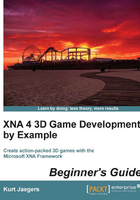
What this book covers
Chapter 1 , Introduction to XNA, begins by installing the Windows Phone Development Tools package that includes the Version 4.0 release of the XNA tools. We will examine the basic building blocks of an XNA game and create a 2D mini game called Speller to establish a baseline of 2D techniques that will be needed while building 3D games later.
Chapter 2, Cube Chaser – A Flat 3D World, introduces basic 3D concepts such as cameras and projections. We will build a floor for our 3D maze using colored triangles and allow the player to walk around on it.
Chapter 3, Cube Chaser – It's A-Mazing!, explores the generation of a random maze layout using the Depth-first search method. We will construct walls based on the generated maze and restrict player movement within those walls.
Chapter 4, Cube Chaser – Finding Your Way, guides us through the construction of the cube we will be chasing, including mapping textures to the faces of an object. We will randomly position the cube and rotate it to perform a simple animation. We will take a closer look at matrix math in order to understand just what is happening when we move, rotate, and scale objects.
Chapter 5, Tank Battles – A War-torn Land, embarks on the building of a tank combat game. In this chapter we will build a new type of 3D camera and generate a terrain based on a heightmap image. We will explore the fundamentals of High Level Shader Language (HLSL) used to create shader effects that describe the surfaces of the objects we will be rendering.
Chapter 6, Tank Battles – The Big Guns, adds 3D models to our game, importing a tank model and positioning it appropriately on the game's terrain. We also delve into bone-based animation for 3D models, allowing the tank's turret and cannon to be moved by the player.
Chapter 7, Tank Battles – Shooting Things, combines our existing 3D elements with a 2D interface, allowing us to accept input from the user via onscreen buttons. We will create and track shots fired by the players and implement billboard-based particle explosions.
Chapter 8, Tank Battles – Ending the War, wraps up the Tank Battles game by incorporating a simple game flow structure to surround game play and establishing a sequence of turns between two players, modifying the state of our user interface elements appropriately. We will determine the result of fired shots, allowing players to score hits on the enemy tank and win the game. Additionally, we will return to HLSL to implement lighting and multitexturing effects on our terrain to improve the graphical quality of the game.
Chapter 9, Mars Runner, begins a new game – a side-scrolling, jumping game on the surface of Mars. We will work with the Game State Management sample code provided by Microsoft to build the structure of our game. The backdrop for Mars Runner will be implemented as a 3D skybox that surrounds the stationary camera. Finally, we will revisit the heightmap-based terrain by generating terrain tiles that can be joined together to create a track for the player's rover to drive on.
Chapter 10, Mars Runner – Reaching the Finish Line, completes the Mars Runner game by enhancing our handling of 3D models and adding both the player's Mars rover and an enemy alien saucer to the game. We allow both the player and the enemy to fire shots at each other and use bounding box collision detection to determine when one of the entities has been hit. To finish up, we will implement a basic sound effect system, allowing us to play audio clips based on the events taking place in the game.